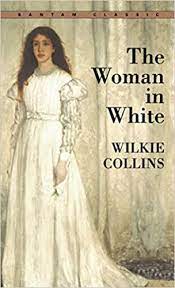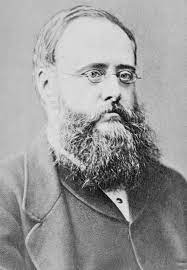The Woman in White Page #14
The Woman in White is Wilkie Collins's fifth published novel, written in 1859. It is a mystery novel and falls under the genre of "sensation novels". The story is an early example of detective fiction with protagonist Walter Hartright employing many of the sleuthing techniques of later private detectives
in its own appropriate midnight darkness. I have been all the morning looking over my mother's letters, and I have made no discoveries yet. However, don't despair, Mr. Hartright. This is a matter of curiosity; and you have got a woman for your ally. Under such conditions success is certain, sooner or later. The letters are not exhausted. I have three packets still left, and you may confidently rely on my spending the whole evening over them." Here, then, was one of my anticipations of the morning still unfulfilled. I began to wonder, next, whether my introduction to Miss Fairlie would disappoint the expectations that I had been forming of her since breakfast-time. "And how did you get on with Mr. Fairlie?" inquired Miss Halcombe, as we left the lawn and turned into a shrubbery. "Was he particularly nervous this morning? Never mind considering about your answer, Mr. Hartright. The mere fact of your being obliged to consider is enough for me. I see in your face that he WAS particularly nervous; and, as I am amiably unwilling to throw you into the same condition, I ask no more." We turned off into a winding path while she was speaking, and approached a pretty summer-house, built of wood, in the form of a miniature Swiss chalet. The one room of the summer-house, as we ascended the steps of the door, was occupied by a young lady. She was standing near a rustic table, looking out at the inland view of moor and hill presented by a gap in the trees, and absently turning over the leaves of a little sketch-book that lay at her side. This was Miss Fairlie. How can I describe her? How can I separate her from my own sensations, and from all that has happened in the later time? How can I see her again as she looked when my eyes first rested on her--as she should look, now, to the eyes that are about to see her in these pages? The water-colour drawing that I made of Laura Fairlie, at an after period, in the place and attitude in which I first saw her, lies on my desk while I write. I look at it, and there dawns upon me brightly, from the dark greenish-brown background of the summer-house, a light, youthful figure, clothed in a simple muslin dress, the pattern of it formed by broad alternate stripes of delicate blue and white. A scarf of the same material sits crisply and closely round her shoulders, and a little straw hat of the natural colour, plainly and sparingly trimmed with ribbon to match the gown, covers her head, and throws its soft pearly shadow over the upper part of her face. Her hair is of so faint and pale a brown--not flaxen, and yet almost as light; not golden, and yet almost as glossy--that it nearly melts, here and there, into the shadow of the hat. It is plainly parted and drawn back over her ears, and the line of it ripples naturally as it crosses her forehead. The eyebrows are rather darker than the hair; and the eyes are of that soft, limpid, turquoise blue, so often sung by the poets, so seldom seen in real life. Lovely eyes in colour, lovely eyes in form--large and tender and quietly thoughtful--but beautiful above all things in the clear truthfulness of look that dwells in their inmost depths, and shines through all their changes of expression with the light of a purer and a better world. The charm--most gently and yet most distinctly expressed--which they shed over the whole face, so covers and transforms its little natural human blemishes elsewhere, that it is difficult to estimate the relative merits and defects of the other features. It is hard to see that the lower part of the face is too delicately refined away towards the chin to be in full and fair proportion with the upper part; that the nose, in escaping the aquiline bend (always hard and cruel in a woman, no matter how abstractedly perfect it may be), has erred a little in the other extreme, and has missed the ideal straightness of line; and that the sweet, sensitive lips are subject to a slight nervous contraction, when she smiles, which draws them upward a little at one corner, towards the cheek. It might be possible to note these blemishes in another woman's face but it is not easy to dwell on them in hers, so subtly are they connected with all that is individual and characteristic in her expression, and so closely does the expression depend for its full play and life, in every other feature, on the moving impulse of the eyes. Does my poor portrait of her, my fond, patient labour of long and happy days, show me these things? Ah, how few of them are in the dim mechanical drawing, and how many in the mind with which I regard it! A fair, delicate girl, in a pretty light dress, trifling with the leaves of a sketch-book, while she looks up from it with truthful, innocent blue eyes--that is all the drawing can say; all, perhaps, that even the deeper reach of thought and pen can say in their language, either. The woman who first gives life, light, and form to our shadowy conceptions of beauty, fills a void in our spiritual nature that has remained unknown to us till she appeared. Sympathies that lie too deep for words, too deep almost for thoughts, are touched, at such times, by other charms than those which the senses feel and which the resources of expression can realise. The mystery which underlies the beauty of women is never raised above the reach of all expression until it has claimed kindred with the deeper mystery in our own souls. Then, and then only, has it passed beyond the narrow region on which light falls, in this world, from the pencil and the pen. Think of her as you thought of the first woman who quickened the pulses within you that the rest of her sex had no art to stir. Let the kind, candid blue eyes meet yours, as they met mine, with the one matchless look which we both remember so well. Let her voice speak the music that you once loved best, attuned as sweetly to your ear as to mine. Let her footstep, as she comes and goes, in these pages, be like that other footstep to whose airy fall your own heart once beat time. Take her as the visionary nursling of your own fancy; and she will grow upon you, all the more clearly, as the living woman who dwells in mine. Among the sensations that crowded on me, when my eyes first looked upon her--familiar sensations which we all know, which spring to life in most of our hearts, die again in so many, and renew their bright existence in so few--there was one that troubled and perplexed me: one that seemed strangely inconsistent and unaccountably out of place in Miss Fairlie's presence. Mingling with the vivid impression produced by the charm of her fair face and head, her sweet expression, and her winning simplicity of manner, was another impression, which, in a shadowy way, suggested to me the idea of something wanting. At one time it seemed like something wanting in HER: at another, like something wanting in myself, which hindered me from understanding her as I ought. The impression was
Translation
Translate and read this book in other languages:
Select another language:
- - Select -
- 简体中文 (Chinese - Simplified)
- 繁體中文 (Chinese - Traditional)
- Español (Spanish)
- Esperanto (Esperanto)
- 日本語 (Japanese)
- Português (Portuguese)
- Deutsch (German)
- العربية (Arabic)
- Français (French)
- Русский (Russian)
- ಕನ್ನಡ (Kannada)
- 한국어 (Korean)
- עברית (Hebrew)
- Gaeilge (Irish)
- Українська (Ukrainian)
- اردو (Urdu)
- Magyar (Hungarian)
- मानक हिन्दी (Hindi)
- Indonesia (Indonesian)
- Italiano (Italian)
- தமிழ் (Tamil)
- Türkçe (Turkish)
- తెలుగు (Telugu)
- ภาษาไทย (Thai)
- Tiếng Việt (Vietnamese)
- Čeština (Czech)
- Polski (Polish)
- Bahasa Indonesia (Indonesian)
- Românește (Romanian)
- Nederlands (Dutch)
- Ελληνικά (Greek)
- Latinum (Latin)
- Svenska (Swedish)
- Dansk (Danish)
- Suomi (Finnish)
- فارسی (Persian)
- ייִדיש (Yiddish)
- հայերեն (Armenian)
- Norsk (Norwegian)
- English (English)
Citation
Use the citation below to add this book to your bibliography:
Style:MLAChicagoAPA
"The Woman in White Books." Literature.com. STANDS4 LLC, 2025. Web. 22 Jan. 2025. <https://www.literature.com/book/the_woman_in_white_1567>.




Discuss this The Woman in White book with the community:
Report Comment
We're doing our best to make sure our content is useful, accurate and safe.
If by any chance you spot an inappropriate comment while navigating through our website please use this form to let us know, and we'll take care of it shortly.
Attachment
You need to be logged in to favorite.
Log In